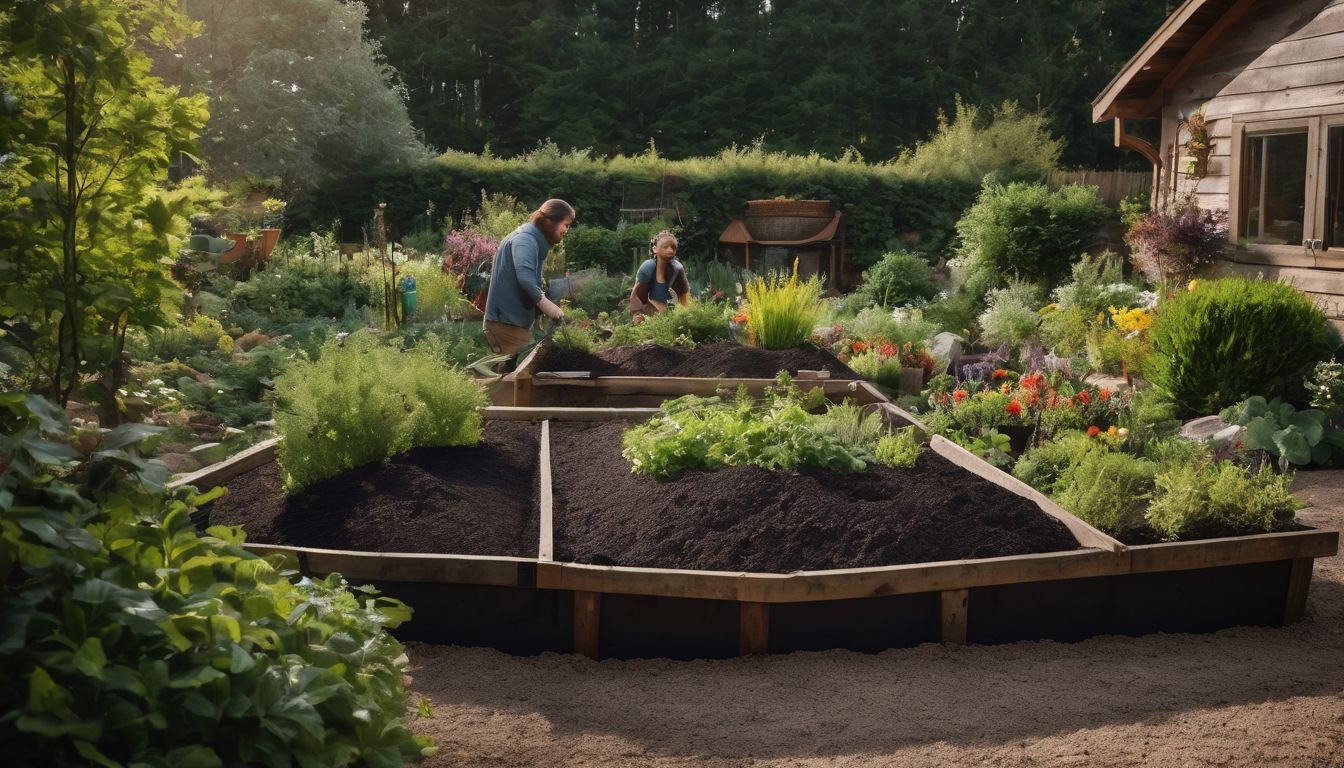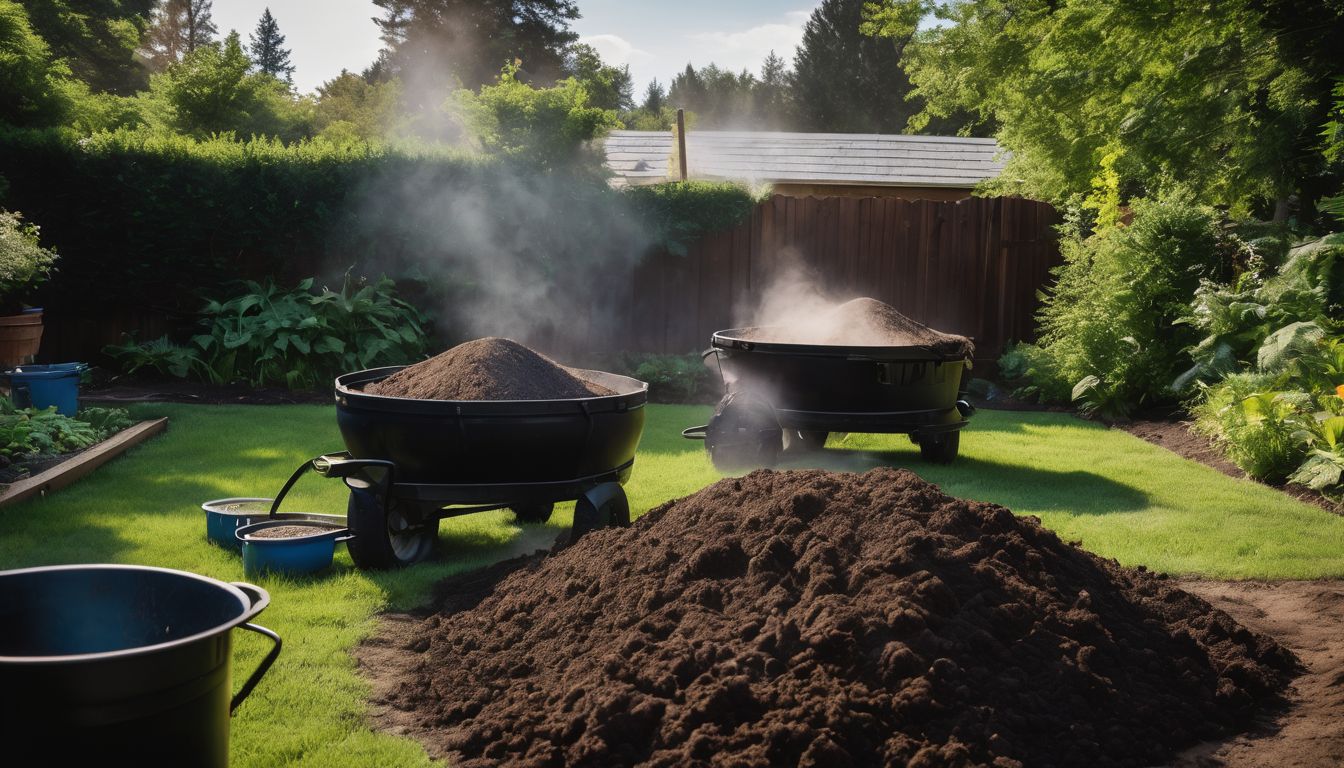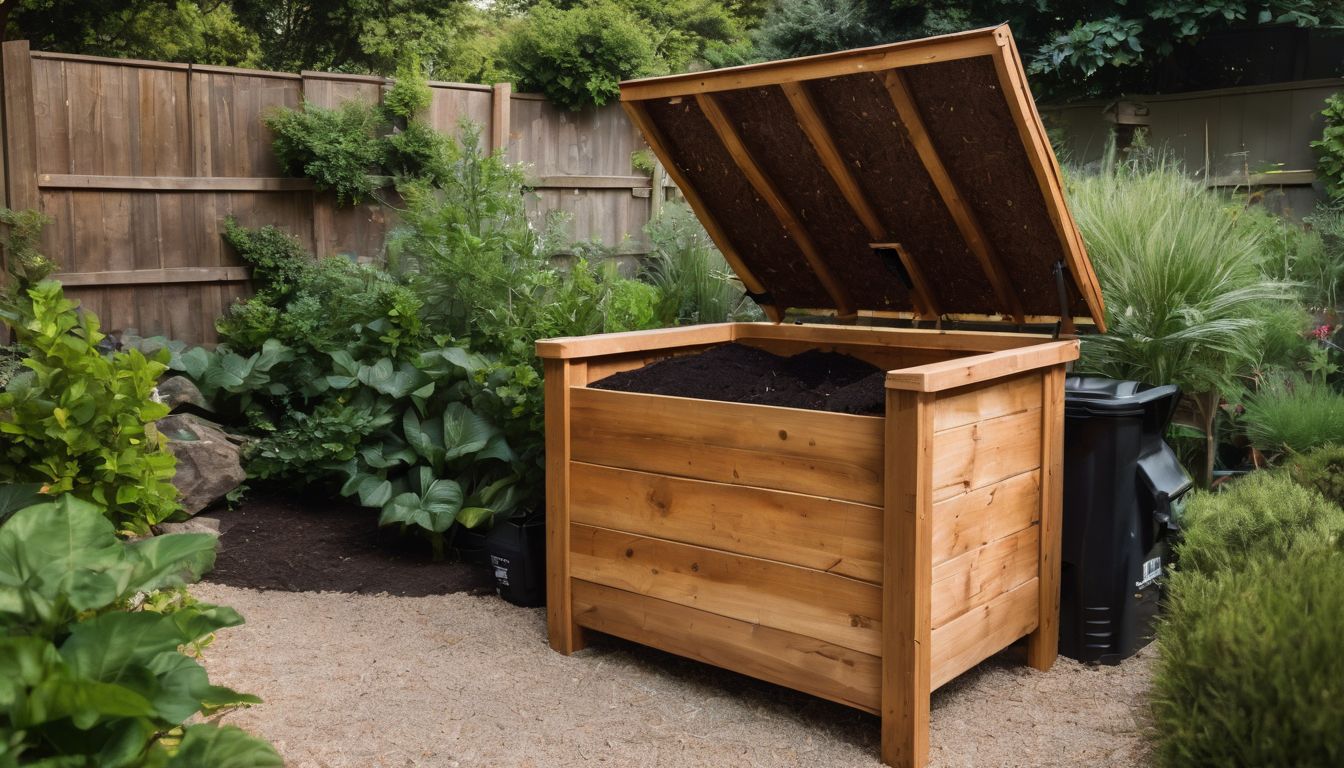Struggling with your compost not breaking down properly? A key secret lies in the balance of carbon to nitrogen. Our article will unravel how this ratio can transform waste into garden gold, leading to healthier soil and plants.
Discover the simple steps for perfect compost!
Key Takeaways
- Achieving the right carbon to nitrogen ratio, typically around 30:1, is key for effective composting and soil enrichment.
- Compost materials include “browns” like leaves and straw for carbon, and “greens” such as food scraps for nitrogen; getting their balance right speeds up decomposition.
- Regularly turn your compost pile to mix the materials and provide oxygen that aids in breaking down organic matter effectively.
- Use mature compost in your garden by adding it to the soil; this boosts plant growth with slow – release nutrients while improving soil health.
- The guidance from experts like those at Cornell University can help people create high – quality compost by understanding proper ratios and maintenance techniques.
What is the Carbon to Nitrogen Ratio in Composting?
The carbon to nitrogen ratio in composting refers to the balance of carbon-rich materials (like leaves and straw) to nitrogen-rich materials (such as food scraps and grass clippings) used in the compost pile.
This ratio is essential for healthy microbial activity and efficient decomposition.
Definition
In composting, the carbon to nitrogen ratio, often written as C:N ratio, is a crucial balance of two elements: carbon and nitrogen. Carbon acts as an energy source for the microorganisms that break down organic matter, while nitrogen is essential for their growth and protein synthesis.
A proper C:N ratio ensures efficient decomposition and creates rich compost ideal for improving soil health.
Organic waste like leaves and wood chips are high in carbon; they’re known as ‘browns’. Nitrogen sources include kitchen scraps or grass clippings, referred to as ‘greens’. Mastering this balance speeds up biodegradation and optimises nutrient cycling in your compost pile.
Too much nitrogen leads to a smelly pile; too little slows down the microbial activity necessary for transforming waste into potent fertiliser.
Importance
Achieving the right carbon to nitrogen ratio in composting is crucial for nutrient balance and fertiliser efficiency. The carbon to nitrogen ratio impacts the breakdown rates of organic materials, ensuring that microorganisms have a healthy diet to work efficiently.
By maintaining an optimal ratio, you can enhance soil fertility while reducing carbon dioxide emissions from organic waste.
Understanding the importance of the carbon to nitrogen ratio is essential for creating high-quality compost that benefits your garden and the environment. By selecting suitable materials with ideal ratios, like nitrogen-rich greens and high-carbon browns, you can support successful composting.
Recommended Carbon to Nitrogen Ratios for Composting
For a hot compost, the ideal carbon to nitrogen ratio is roughly 30:1. However, successful composting can still be achieved with a wider range of ratios, with the estimated range typically falling between 25:1 to 40:1.
Best ratio for hot compost
Achieving the best ratio for hot compost requires a careful balance of carbon to nitrogen, typically aiming for a range between 25:1 and 30:1. This means incorporating more carbon-rich materials such as straw, wood chips, or dried leaves compared to nitrogen sources like grass clippings and kitchen scraps.
Maintaining this ideal ratio is crucial in supporting the rapid breakdown of organic matter through microbial activity, ensuring efficient heat generation and decomposition.
To achieve these optimal composting conditions, environmentally conscious individuals can measure out their ingredients by weight or volume to ensure they are achieving the recommended carbon to nitrogen ratios.
Estimated ratios for successful composting
After understanding the best ratio for hot compost, it’s important to consider the estimated ratios for successful composting. These ratios are crucial for creating a balanced and nutrient-rich environment. Here are the estimated ratios:
- Aim for a C:N ratio of 25 – 30:1 for optimal decomposition.
- High – carbon materials should be used in higher quantities to maintain the ideal ratio.
- A slightly wider range of 20-40: 1 can also support successful composting under varying conditions.
- Regular monitoring and adjustment may be needed based on the materials added and environmental factors.
Understanding the Role of Carbon and Nitrogen in Compost
Carbon and nitrogen play essential roles in the breakdown of organic material in compost. Understanding their individual contributions can help create a healthy, nutrient-rich environment for microorganisms to thrive and transform waste into valuable compost.
Breakdown rates
Microorganisms play a crucial role in breaking down the materials in a compost pile. They require an ideal carbon to nitrogen ratio to thrive and efficiently decompose organic matter.
The breakdown rates of different materials are affected by their carbon and nitrogen content, with high-carbon items like wood chips taking longer to break down than high-nitrogen items such as grass clippings.
Balancing the carbon to nitrogen ratio ensures that microorganisms have access to the nutrients they need for effective decomposition. This balance promotes efficient breakdown rates, creating a healthy environment for beneficial organisms and yielding nutrient-rich compost that is valuable for enriching garden soil.
Balancing a healthy diet for microorganisms
After understanding the breakdown rates of carbon and nitrogen in composting, it is essential to balance a healthy diet for microorganisms. Microbes require an ideal mix of carbon-rich “brown” materials like wood chips or straw, and nitrogen-rich “green” materials such as grass clippings or fruit scraps to thrive.
Maintaining this balance ensures that the compost pile heats up sufficiently to kill pathogens while breaking down organic matter efficiently.
To support these vital processes, environmentally conscious individuals can incorporate high-carbon sources like shredded paper or cardboard with nitrogen-rich additions such as vegetable peels and coffee grounds.
Choosing the Right Materials for Composting
When it comes to composting, it’s crucial to choose the right materials. Understanding nitrogen-rich and carbon-rich materials can help create a successful compost pile.
Nitrogen-rich materials
Nitrogen-rich materials are vital for successful composting. They provide the necessary nutrients for microorganisms to break down organic matter effectively. Incorporate these nitrogen-rich materials into your compost pile:
- Grass clippings: Provide a quick source of nitrogen, ensuring a healthy balance.
- Fruit and vegetable scraps: High in nitrogen, add them regularly to your compost.
- Coffee grounds: A rich source of nitrogen that will enrich your compost.
- Alfalfa meal: A potent nitrogen input for your compost pile.
- Recommended products
Recommended products
To achieve the optimal carbon to nitrogen ratio in composting, consider using these recommended products:
- Manure from herbivores: Cow, horse, or rabbit manure are excellent nitrogen sources with a good C:N ratio for composting.
- Fruit and vegetable scraps: These kitchen waste products provide nitrogen and help balance the C:N ratio in the compost pile.
- Coffee grounds: A high-nitrogen organic material that can be added to the compost to boost microbial activity.
- Grass clippings: Freshly cut grass contains a high amount of nitrogen and can be used as a green material in the compost pile.
- Alfalfa meal: This is an excellent source of nitrogen with a balanced C:N ratio suitable for hot composting.
High carbon and high nitrogen examples
High carbon examples include sawdust, wood chips, and cardboard. These are important to balance the compost heap with nitrogen-rich materials such as grass clippings, food scraps, and coffee grounds. The combination of these materials ensures a healthy composting process. Additionally, items like fruit and vegetable peels, eggshells, and coffee filters provide the necessary nutrients for microorganisms to thrive. Other high carbon sources include straw, leaves, and shredded paper.
Greens and browns with ideal ratios
When composting, aim to combine “greens” and “browns” in an ideal ratio.
- Green materials such as grass clippings, fruit and vegetable scraps, and coffee grounds provide nitrogen.
- Brown materials like dry leaves, straw, wood chips, and shredded paper supply carbon.
- A good starting point is a 2: 1 ratio of browns to greens for successful decomposition.
- Adjust the mix based on how quickly the pile breaks down; too much green can lead to odors or a soggy heap.
- Aim for a mix that is visually appealing: mostly browns with splashes of green.
Maintenance and Usage of Compost
Location and equipment needed for maintaining a compost pile, as well as using compost in your garden, will be discussed in detail. To learn more about how to properly maintain and use compost, continue reading the full blog post.
Location and equipment needed
To start composting, you need a suitable location that receives partial sunlight. Choose a spot close to your garden or kitchen for easy access. Gather the following equipment: a pitchfork, shovel, tarp or cover, and water source nearby.
Consider using a compost bin or building a simple structure with wire mesh and wooden stakes for better containment of materials.
Building and maintaining a compost pile
Building and maintaining a compost heap involves selecting a suitable location and acquiring the necessary equipment. Begin by choosing a dry, shady spot for your compost heap to prevent it from drying out too quickly or becoming waterlogged.
Using compost in your garden
After your compost has matured for several months, it’s ready to be used in your garden. Spread a layer of compost about 5 centimetres thick on the soil surface around plants or work it into the top 10-15 centimetres of soil before planting. Water thoroughly after applying compost to help integrate it into the soil.
- The nutrients and organic matter in the compost will nourish your plants and improve soil structure.
- Compost also helps retain moisture and suppress diseases, reducing the need for chemical fertilisers and pesticides.
- As it decomposes, compost releases nutrients slowly, providing a steady supply of nourishment for your plants throughout the growing season.
- Using compost enriches the biodiversity of microorganisms in the soil, contributing to a healthy garden ecosystem.
Acknowledging expert guidance from Cornell University
Cornell University provides invaluable expertise on composting, guiding individuals toward sustainable practices. Understanding the carbon to nitrogen ratio is crucial for successful composting, and Cornell’s research offers practical insights into achieving an optimal balance.
With their guidance, environmentally conscious individuals can effectively manage their compost piles with the right materials and ratios for nutrient-rich soil.
From selecting nitrogen-rich materials to maintaining the compost pile and using the final product in gardens, Cornell’s advice covers every aspect of sustainable composting. Their expert guidance ensures that enthusiasts can make a meaningful contribution to conservation efforts by effectively managing organic waste through proper composting techniques.
Conclusion
Understanding the importance of carbon to nitrogen ratio in composting is crucial for successful decomposition. This balance ensures that microorganisms have the right diet to break down organic materials efficiently.
By choosing the appropriate materials and maintaining a healthy compost pile, you can contribute positively to the environment while creating nutrient-rich soil for your garden. Successful composting relies on understanding and implementing the correct carbon to nitrogen ratios, ensuring a sustainable approach towards waste management and gardening practices.
FAQs
1. What is the carbon to nitrogen ratio in composting?
The carbon to nitrogen ratio, or compost ratio, is the balance of carbon-rich materials and nitrogen-rich materials needed for effective composting.
2. Why is the right compost ratio important?
Having the correct compost ratio helps break down organic matter efficiently, creating healthy compost for plants.
3. Can my compost work with too much carbon or nitrogen?
No, if there’s too much carbon, your compost may take longer to decompose; too much nitrogen can make it smelly and wet.
4. How do I find the right balance for my compost?
For a good balance in your composter, aim to mix roughly equal amounts by weight of dry ‘browns’ (carbon) and wet ‘greens’ (nitrogen).





